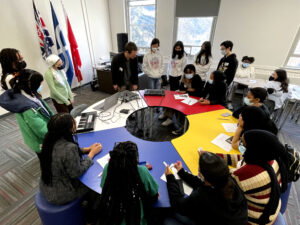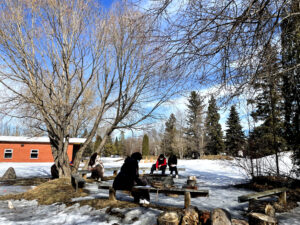
This somewhat abstract but provocative question about the sound of hope was contextualized in relation to the broader themes and questions of the Youth Summits: day one centered on the idea of “Ways of Knowing,” where students were tasked with thinking through the epistemological lenses that structure how we learn to care (or not) for one another, for the land, and for ourselves; and day two was focused on “Anti-racism,” where students were brought together to collectively propose actionable projects committed to creating anti-racist schools.
The question posed by our young friend about the workshop, about its links and commitments to anti-racism, was raised in the final moments of the last workshop when we gathered as a group to discuss how working with sound might offer insights into some of the broader Summit themes. The question, which continues to reverberate for me well beyond the walls of the workshop classrooms, offered an important interference, and, in my mind, an integral opening, to really dig into why and how something like a 75-minute arts-based pedagogical workshop matters, if at all, when it comes to countering something like the colonial and white supremacist systems of oppression that continue to structure spaces of schooling.
In the moment, I took a back seat in responding to this crucial question; instead of sharing the eruption of thoughts elicited in my own mind, I asked the group what they thought. Several hands shot up right away. As the question percolated throughout the room, the youth responded in all sorts of ways, offering powerful insights on, for instance: how art and expression can create a sense of belonging; how having a space to use one’s voice in emergent ways can be empowering; how making things together requires active practices of listening and collective experimentation; how sound offers a “language” that stretches across boundaries, changing those boundaries in the process; and, how performing for peers can highlight the deep well of knowledge and “excellence” that already exists in communities. I was blown away, but perhaps not surprised, by their responses, which continue to roll around in my head now weeks after the event.
While there might be an impulse here to collect these responses as important “data” for demonstrating the impact of our project, and by extension the power of art and/or arts-based approaches, I am reluctant to treat this moment as a research “finding” or “outcome.” Data, after all, works through reduction and generalization, in turn factoring out the vicissitudes of entanglement that make up relations in the world. Indeed, both quantitative and qualitative approaches to data collection and analysis, such as those used within educational research, tend to prioritize consistency over contingency, standardization over difference and thus the reduction of complexity in favour of tidy causal determinations and straight-forward correlations. Whereas quantitative data practices often necessitate the discrete division between subject and object or researcher and object of study, in turn creating “a fantasyland in which databases and correlational numbers have served as substitutes for realities” (Snaza & Weaver, 2015, p. 9), in qualitative research, the subject-object invention supported by data protocols has led to an apologetic posture wherein the researcher must “mourn his or her inability to capture an uncertain, confusing, complex, and always shifting reality” (Snaza & Weaver, 2015, p. 9). In both cases, researchers dissimulate behind data while nevertheless proclaiming access to a world where data “speaks” for itself.

Thinking back to the provocative student question that opened this reflection, then, what sticks with me now is perhaps not just how this expression of curiosity provided an intrusion into our tidy debrief activity, and not just the insightful responses it elicited, but how it worked, and continues to work, to frustrate the assumptions that often undergird purportedly transformative educational initiatives (not to mention their well-intentioned researchers), in turn impacting how we might collectively create landscapes of and for hope.
Text by Jessie Beier, photos courtesy of Jay Procktor




 Français
Français